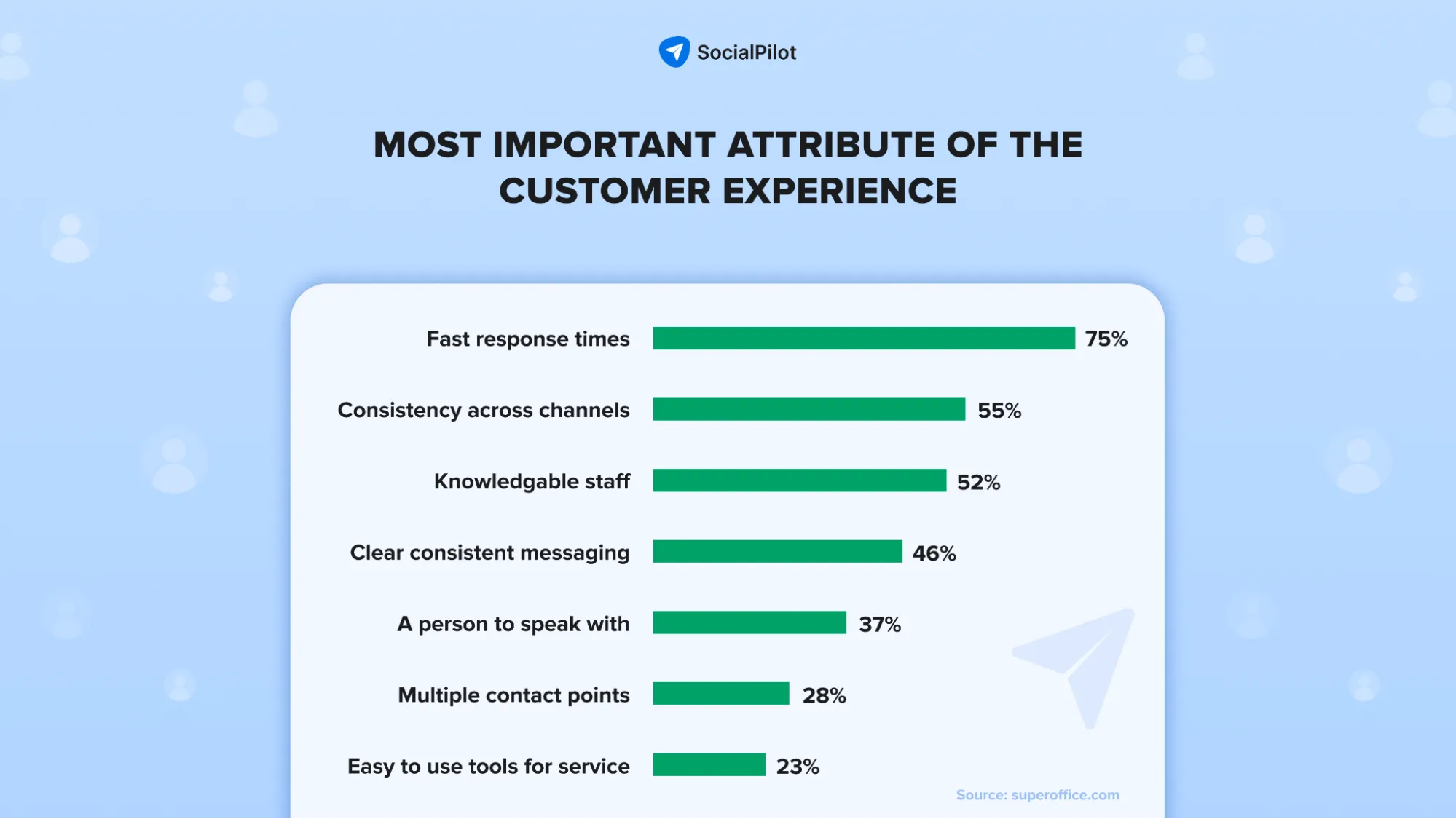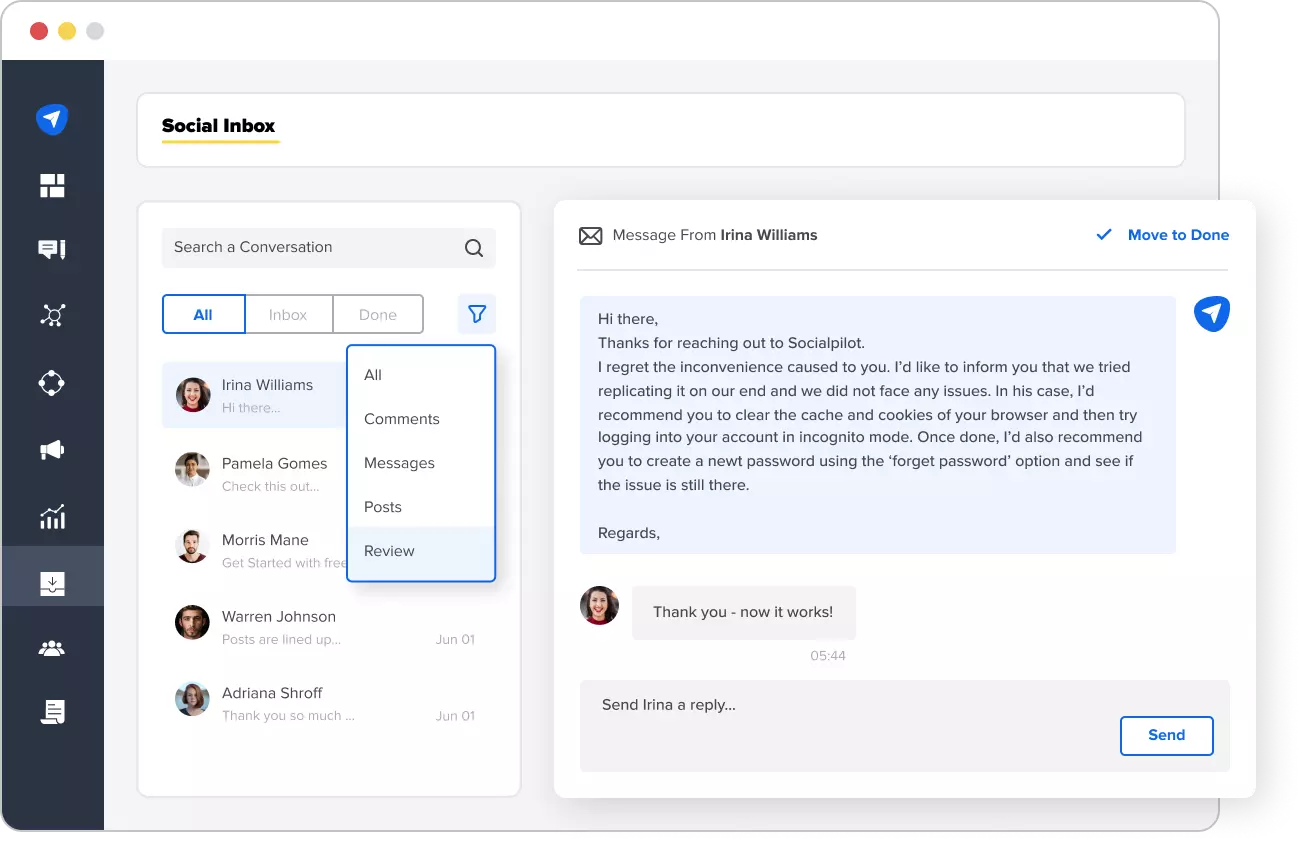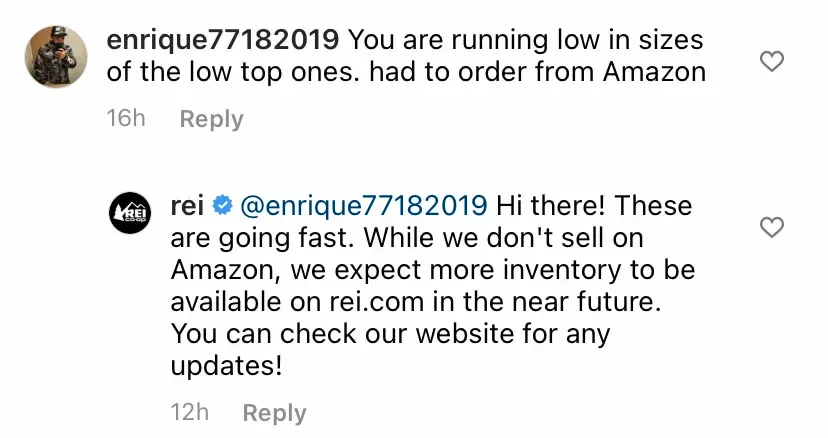In the era before social media dominance, reaching out to a business often meant enduring tedious hold music or navigating a maze of email threads. Today, with the ubiquity of social media platforms, customers have found a more direct and engaging channel to communicate with businesses.
As billions flock to these platforms, the importance of delivering top-notch social media customer service has skyrocketed. It’s no longer just an option—it’s a necessity for brands excelling in social media customer service aiming to uphold a commendable reputation.
This guide will dive into eight actionable tips to elevate your social media customer service. From swift and professional responses to devising a robust strategy, these insights will enhance your brand’s online presence and fortify its relationship with customers.
Let’s discover how you can transform your social media channels into customer service powerhouses using best practices for social media customer service.
But, before that, let’s answer an important question…
What is Social Media Customer Service?
Social media customer service is the proactive and reactive support businesses offer customers across various social platforms like Facebook, Twitter, and Instagram using social media customer support tools.
Gone are the days when customers had to endure long hold times on the phone or wait for email responses. With the rise of social media, customers can now reach out to businesses 24/7, making their interactions more direct and engaging.
How does this matter?
This shift in communication dynamics has led to a more conversational approach to customer service. It offers a personal touch, promoting positive experiences between businesses and their customers. In fact, a staggering 64% of Twitter users have expressed a preference for tweeting at brands over making a traditional phone call.
So, what does exemplary social media customer service entail?
- Quick Response Time: A prompt reply, ideally within 24 hours, demonstrates to customers that their concerns are valued and prioritized. This is one of the essential social media customer service metrics that brands should monitor.
- Professional Tone: The manner in which businesses communicate on social platforms significantly influences public perception. Maintaining a courteous and respectful tone is paramount to upholding a brand’s positive image, especially when figuring out how to handle negative feedback on social media.
- Empathy: Understanding and addressing customer concerns with genuine empathy is foundational to creating a pleasant customer experience. Organizations that prioritize understanding their customers’ needs and feelings foster stronger relationships and drive customer success, as highlighted by Forbes.
In essence, social media customer service simplifies the communication process, making it more efficient and user-friendly for both businesses and their clientele.
Moving on:
Let’s discuss benefits of social media customer service and how you can provide excellent social media customer service.
10 Tips for Providing Great Social Media Customer Service
Enhancing your social media customer service doesn’t have to be complex. Here are the eight tips to make your approach both simple and impactful:
1. Brand Monitoring With Social Media Customer Support Tools
In the vast social media landscape, conversations about your brand can spring up anywhere, often beyond the confines of your official pages. Training teams for social media customer service is crucial to ensure that they can effectively monitor and respond to these mentions.
Investing in robust social media listening platforms can capture a holistic view of your brand’s perception. These tools can scan various platforms, forums, and even blogs, differentiating between neutral mentions, praises, and complaints. Prioritize mentions based on their urgency and potential impact. Engage constructively with those praising your brand, fostering loyalty, and address complaints with a solution-oriented mindset.
This proactive approach helps damage control and showcases your brand’s commitment to continuous improvement.
2. Respond Quickly on Social Media
Customers expect almost instantaneous responses nowadays. The adage “time is money” has never been more accurate. However, it’s not just about speed; the quality of your response holds equal weight.

While customers appreciate prompt replies, they value thoughtful, solution-driven responses even more. To strike this balance, set up an immediate acknowledgment system, assuring customers that their query is registered. Follow this up with a detailed, human response that addresses their concerns.
To respond quickly, make sure you…
3. Use Canned Responses, but Wisely
When used judiciously, canned responses can be a boon for social media customer service. They offer the dual benefit of speed and consistency. However, the challenge lies in ensuring these responses don’t come off as impersonal or robotic.
The solution? Use them as a foundation, but always add a touch of personalization.
By categorizing common queries and crafting base responses for each, you create a starting point. Encourage your team to tailor these responses based on the specific nuances of each customer interaction. This approach ensures efficiency without compromising on the personal touch that customers value.
4. Use a Friendly Tone
The tone you adopt in your social media customer service can significantly influence a customer’s perception of your brand. A friendly and approachable demeanor can make customers feel valued and understood, fostering loyalty. On the other hand, a tone that comes across as cold or distant can deter them. To strike the right chord:
- Incorporate personal pronouns like “you” and “I” to establish a connection.
- Engage as if you’re having a face-to-face conversation, keeping it light yet professional.
- Express genuine interest in their concerns, using affirmations like “happy to assist.”
- Steer clear of jargon that might confuse or alienate them.
- Be cautious with your use of capital letters and exclamation points to avoid seeming aggressive.
- Consistency is key, especially if multiple team members handle your social media. Setting a clear brand voice guideline can ensure uniformity in interactions.
5. Listen to Your Customers
Every customer wants to feel acknowledged. Especially when they face issues, be it supply chain delays or product faults, they seek understanding and prompt resolution. Demonstrating empathy goes beyond just hearing them out; it’s about understanding their perspective and validating their feelings.
By actively listening, which includes echoing their concerns and seeking clarity when needed, you not only address their immediate needs but also build a foundation for long-term trust.
Next, make sure to…
6. Personalize Your Interactions
Personalization goes beyond just using a customer’s name. It’s about making each interaction feel unique and tailored to the individual’s needs and preferences.
- Know Your Customer: Utilize data analytics to understand your customer’s preferences, past interactions, and purchase history. This knowledge can guide your interactions, making them more relevant and meaningful.
- Tailored Solutions: Instead of offering generic solutions, strive to provide answers that cater to the specific needs of the customer. This shows that you’ve taken the time to understand their unique situation.
- Recommendations: Based on their interests and past interactions, suggest products, services, or content that might be of value to them. This not only enhances their experience but can also drive additional sales.
- Celebrate Milestones: Recognize and celebrate milestones in your relationship with the customer, be it their birthday, anniversary with your brand, or any other significant event. Such gestures can make customers feel truly special and valued.
- Feedback Integration: Show customers that you value their feedback by integrating their suggestions into your services or products. This not only improves your offerings but also makes customers feel like they’re a part of your brand’s journey.
An effective tool to personalize interactions is SocialPilot’s Social Inbox. This feature helps managing and responding to all customer interactions across various platforms in a centralized manner, ensuring that each response is tailored and personalized to the individual’s query.

Now, here’s something you might not have considered…
7. Conduct a SWOT Analysis
Continuous introspection is the key to sustained success in social media customer service. While it’s tempting to adhere to the “if it ain’t broke, don’t fix it” philosophy, it’s essential to periodically assess the efficacy of your strategies.
A SWOT analysis serves as a beacon in this endeavor, illuminating the strengths that set your service apart, the weaknesses that need attention, potential opportunities ripe for the taking, and looming threats that could derail your efforts.
By holistically evaluating these four facets, you can cultivate a deeper understanding of both your internal operations and the external landscape. This fosters open dialogue about your customer service blueprint and unveils areas that might benefit from additional resources or skill enhancement.
8. Know When to Take Things Offline
The allure of social media lies in its immediacy and reach. However, it’s crucial to recognize its limitations. While it’s an invaluable platform for initial engagement, certain conversations necessitate a more private setting.
Situations that involve the exchange of sensitive information, like credit card details, are ill-suited for the public domain of social media. Similarly, intricate issues that demand extensive discussions are better addressed through more direct channels, such as phone calls or emails.
The transition from online to offline should be executed with finesse. It’s not merely about shifting the conversation; it’s about ensuring the customer feels valued and understood throughout the process.
What you can also do is…
9. Establish a Specialized Social Media Support Channel
To expedite response times and provide detailed solutions, it’s beneficial for brands to have a distinct social media account dedicated solely to customer support.
For instance, while a brand might have a primary handle like “@BrandName,” they could also operate a support-focused handle like “@BrandNameSupport.” Managed by the customer service team, this approach segregates promotional content from support queries, ensuring each message is addressed by the appropriate department. To guide customers effectively, mention this dedicated support handle in the bio of your primary social media profiles.
However, be prepared: some customers might still reach out to the main brand handle for support. In such cases, swiftly redirect them to the dedicated support channel for a more specialized response.

Twitter does this right with a dedicated handle “@Support” to address user issues, provide solutions to common problems, and offer guidance on platform usage. This separation ensures that users seeking assistance can get direct, specialized help without their queries getting lost amidst promotional or informational tweets.
10. Implement a Support Chatbot for Routine Queries
Chatbots are capable of providing round-the-clock assistance on social media. In fact, By 2027, chatbots are predicted to become the primary channel for customer service in a quarter of all businesses (Gartner).
Especially useful during off-hours, conversational chatbots like those from Smartsupp can instantly address frequently asked questions, ensuring customers receive timely information even when your human team isn’t available. While chatbots excel at handling routine inquiries, it’s essential to have a system where more complex issues are seamlessly transferred to human agents.
Let’s put all these tips to good use with some amazing tools for social media customer service, shall we?
5 Tools for Effective Social Media Customer Service
Navigating challenges in social media customer service becomes simpler with the right tools. Here are five that stand out:
1. SocialPilot

SocialPilot is a comprehensive tool designed to enhance social media customer service. One of its standout features is the unified dashboard, which consolidates interactions from various social platforms, ensuring that customer queries and mentions don’t go unnoticed.
The platform’s Social Inbox streamlines communication by centralizing messages from different channels, making it easier for teams to manage and respond to inquiries in real time.
There’s also an analytics tool that provides valuable insights into content performance and audience engagement patterns. By analyzing these metrics, brands can better understand their audience’s preferences, the best times to post, and the overall effectiveness of their marketing strategy.
This data-driven approach ensures that businesses can optimize their content and engagement strategies to resonate more effectively with their target audience.
The platform boasts a content scheduling feature, which, while primarily for content management, can be leveraged to schedule timely customer service announcements or updates.
With its intuitive interface, teams can easily navigate through features, making the management and response process more efficient.
2. Zendesk
A renowned customer service platform, Zendesk offers a dedicated suite for social media interactions. The platform consolidates customer queries from various social channels into a single dashboard, ensuring efficient response management with its intuitive ticketing system.
3. Freshdesk
Freshdesk‘s multi-channel customer support platform seamlessly integrates social media channels. Features like automated ticketing, collision detection, and smart notifications ensure prompt and effective responses to customer queries on social platforms.
4. LiveAgent
LiveAgent is a customer support platform integrating with social media channels like Facebook, Twitter, and Instagram. It centralizes inquiries, ensuring timely responses. Features include ticketing, live chat, and a knowledge base, streamlining social media interactions for businesses. Ideal for efficient social media customer service management.
5. HappyFox
HappyFox offers a unified customer support platform integrating social media channels. The platform allows businesses to track, prioritize, and respond to customer queries efficiently, with robust reporting features for performance assessment.
Want to see all of this in action? Let’s look at…
3 Social Media Customer Support Examples
Let’s see in action with some real-world examples of how companies leverage social media for customer service.
1. Wendy’s Engaging and Timely Responses
Wendy’s, a popular fast-food chain, is known for its witty and engaging presence on Twitter. Their approach to customer service is no different. When a customer reported an issue with their order, Wendy’s promptly acknowledged the problem and sought specific details to assist further.

Their strategy revolves around acknowledging issues, offering solutions, and continuously refining their workflows to enhance the customer experience.
2. Spotify on Twitter
Spotify, the music streaming giant, is another brand that effectively uses social media for customer service. They have a dedicated Twitter account, @SpotifyCares, where they address user issues, answer queries, and provide solutions. The account is known for its quick responses and helpful solutions.

For instance, if a user is facing issues with their playlist or has billing queries, they can reach out to this handle for a swift resolution. By actively addressing user concerns on social media, Spotify ensures customer satisfaction and loyalty.
3. REI
REI, a leading outdoor equipment brand, consistently showcases stellar customer service on its Instagram account. Almost every pressing customer question receives a thoughtful reply, and even the less urgent ones don’t go unnoticed. The brand’s approach is characterized by its warmth, approachability, and comprehensive information, ensuring that every interaction feels valued.

In one notable instance, a customer pointed out a shortage of a specific shoe size in REI’s online store. REI’s response was both prompt and amicable, assuring the customer of an upcoming restock. Even though the customer might have turned to another retailer, REI’s proactive engagement ensures they remain top-of-mind for future purchases.
5 Benefits of Social Media Customer Service
Businesses today are increasingly recognizing the importance of leveraging social media for customer service. Not only does it offer a platform for marketing and brand promotion, but it also provides an avenue for direct interaction with customers.
Here are five compelling benefits of integrating social media into your customer service strategy:
1. Faster, Easier Communication
Social media platforms like Twitter, Facebook, and Instagram allow customers to reach out to brands in real-time. This immediacy fosters a sense of connection and trust. Customers no longer have to wait in long phone queues or navigate complicated IVR systems. A simple tweet or direct message can get their concerns addressed promptly.
2. 24/7 Availability
The internet never sleeps, and neither does social media. With platforms accessible around the clock, customers from different time zones can seek assistance at their convenience. This 24/7 availability ensures that brands cater to a global audience, enhancing customer satisfaction and loyalty.
For instance, Zappos, known for its exceptional customer service, has a dedicated social media team that responds to customer inquiries and complaints within minutes, 24/7, ensuring that no query goes unanswered regardless of the time of day.
Think that’s impressive, consider this:
3. Personalized Customer Interactions
Social media gives businesses an opportunity to provide a tailored service experience. By analyzing a customer’s profile, preferences, and past interactions, brands can offer solutions that resonate with individual needs. This personal touch not only addresses the immediate concern but also strengthens the customer-brand relationship.
4. Proactive Issue Resolution
Companies can proactively address potential issues before they escalate by monitoring mentions, hashtags, and brand-related discussions.
A notable example of this is the way JetBlue Airways operates on Twitter. In one instance, a customer tweeted about a broken in-flight entertainment system. Before the flight even landed, JetBlue was not only aware of the issue but had also issued a credit to the customer’s account as compensation.

This swift and proactive approach not only mitigated potential negative publicity but also showcased JetBlue’s commitment to customer satisfaction
Last but not least:
5. Enhanced Customer Insights
Social media platforms are a goldmine of customer feedback. By analyzing comments, reviews, and direct messages, brands can gain invaluable insights into customer preferences, pain points, and expectations. These insights can then be leveraged to refine products, services, and overall customer experience.
Conclusion
Managing social media customer service is a delicate balance of proactive engagement and timely response. Just as a flourishing garden requires consistent care and attention, your brand’s online reputation thrives when you’re attuned to your customers’ needs and feedback. However, any lapse can lead to challenges that might be hard to navigate.
By following our guidelines, you ensure that every customer feels acknowledged and appreciated. In today’s interconnected world, where a single customer experience can shape perceptions, a well-defined strategy is indispensable. With the right approach, you can ensure that no customer feels left behind or unheard.




